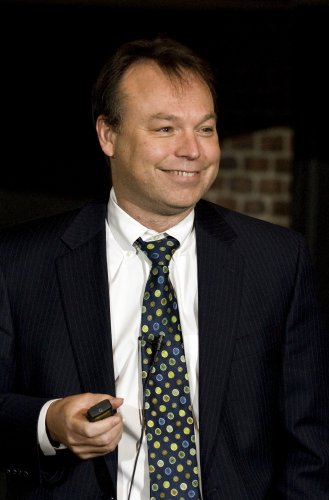
Jeff Balser, M.D., Ph.D., at last week’s Dean’s Lecture. (photo by Susan Urmy)
Time to ‘own’ public health problems: Balser
By nearly any measure, from National Institutes of Health funding to scientific publications to reputation, Vanderbilt Medical Center has achieved extraordinary growth over the past decade.
“But we shouldn't be satisfied,” Jeff Balser, M.D., Ph.D., told those who packed a Light Hall lecture hall for his Dean's Lecture last week.
The United States is No. 2 in per capita spending on health, yet ranks embarrassingly low when it comes to life expectancy and other measures of health care quality.
Each year, 125,000 hospitalized patients die from serious adverse drug events. “That's like a 747 going down every single day,” said Balser, the 11th dean of Vanderbilt University School of Medicine and associate vice chancellor for Health Affairs. “How is that possible?”
Tennessee has among the nation's highest cancer death rates. “Unfortunately, I could remove the word 'cancer' and substitute 'obesity,'” he continued. “I could substitute 'diabetes.'”
“We must solve these problems or they won't be solved,” Balser said. “We have a huge responsibility to this community, to this state and to society to take these problems seriously and own them.”
The Medical Center already has taken some impressive steps in that direction. Several years ago, Vanderbilt researchers showed that a team approach to caring for hospitalized patients with indwelling catheters could reduce bloodstream infections by 50 percent.
Their example, adopted by more than 2,000 hospitals nationwide, prevents 5,000 deaths annually and has saved an estimated $1 billion.
“Just imagine the impact we could have if we applied this kind of thinking to all the different problems we have in health care delivery,” Balser said.
Yet health care information is exploding so rapidly that the human brain cannot keep up, he said. Add that to the fact that only about a third of a person's life expectancy is determined by genetics — the rest is decided by behavioral and other environmental factors.
“That is one of the biggest challenges in personalized medicine … managing the information,” Balser said. “It is inescapable … We're going to have to train our students and our residents in how to utilize that information, and … how to make sure it's the right information.”
An example is Vanderbilt's “ventilator dashboard,” an informatics-based checklist that has cut in half the rate of ventilator-acquired pneumonia. Imagine, Balser said, if such a dashboard was used to manage high-risk pregnancies in a community clinic. “If we did that, it would not only reduce mortality, I'll wager it would also reduce costs,” he said.
But doctors can't do it all. Vanderbilt's research enterprise, for example, counts heavily on hundreds of Ph.D.-level scientists and post-doctoral fellows, graduate students and highly trained laboratory staff, pharmacists and nurse researchers.
“There is no way we could possibly educate enough physicians to manage the growth of the population and its need for health care,” Balser said. “Vanderbilt could expand its medical class from 100 to 500, and every medical school in the country could do that, and we'd still be off by 50 percent.
“We must come to terms with how we will work as a team with other health care providers.”
Just as the famed Abraham Flexner tested many of his ideas for reforming U.S. medical education at Vanderbilt nearly a century ago, “maybe Vanderbilt is the place that needs to lead the next Flexnerian revolution in health care education,” Balser said.
To view Balser's lecture, go here.













